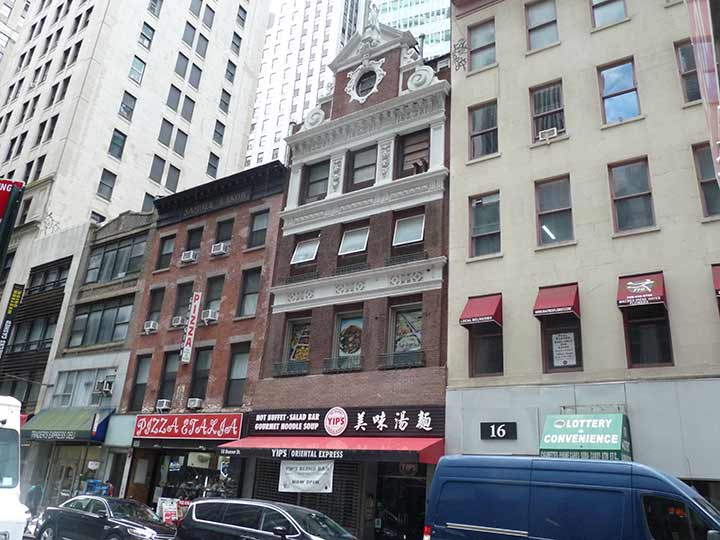
I recently revisited Beaver Street, downtown in the financial district. One of Manhattan’s oldest streets was named very early on, in the 1660s, and commemorates the paddle-tailed, dam-building, aquatic rodent whose pelts made up the chief avenue of commerce between Dutch settlers and the already established Native Americans during New Amsterdam’s earliest days from the 1620s through the 1650s, after which sales of beaver pelts fell off greatly.
Nevertheless beavers continued to be much prized for centuries, so much so that the wealthiest man in America during his time, John Jacob Astor, made his fortune on beaver fur, and representations of the beaver are seen in the official seal of New York City (along with a number of other puzzling artifacts that are decoded on this page; and, of course, terra cotta beavers can be seen in the Astor Place station, named for John Jacob.

18 Beaver Street (at Marketfield Street) caught my eye not only for the old school Yip’s Restaurant sign but what I found on the pediment at the top. It was likely before this particular 3-story building was constructed, but 18 Beaver was once the home of Thomas Williams, scion of the family of “the oldest and largest firm in the world dealing in mahogany and other imported cabinet woods.”
The girl on the pediment is likely Hebe. I am not trying to be insulting — Hebe (pronounced AY-bay) was the ‘cupbearer of the gods’ in classic myth. One of the little details that Beaux Arts architects, who no doubt studied the classic myths in school, provided on buildings to make them beautiful. A trifle, lost from the practices of today.
The building next door, 20 Beaver, is over a century old and has a varied history, according to the former site The Masterpiece Next Door, which sadly has been taken down:
20 Beaver Street looks like a Federal-style (right? Federal?) warehouse. Some net-sleuthing connects the site (and probably the building itself) to the Holmes & Haines cabinetmaking company starting at some indeterminate point early in the 1800s. By 1901, it is home to George A. Kessler & Co.; Kessler was a wine merchant written about in numerous New York Times articles, including one about his escape from the Lusitania disaster and another on a mad expensive $300-a-plate “polar party.” Later it became home to Samuel Lakow‘s custom office furniture business.
While the Lakow office furniture painted ad seen on on the Indispensable Walter Grutchfield’s site at the above link, has been expunged from North Moore and Hudson Streets, Mr. Lakow will apparently have a presence at 20 Beaver for as long as it stands.
As always, “comment…as you see fit.” I earn a small payment when you click on any ad on the site. Take a look at the new JOBS link in the red toolbar at the top of the page on the desktop version, as I also get a small payment when you view a job via that link.
10/5/24


1 comment
Thanks Kevin. Always fascinated by your posts.
FYI…
herewas.com has more info on the backstories of places on Beaver Street.